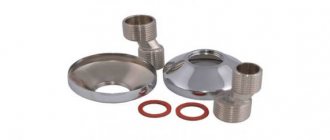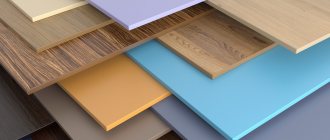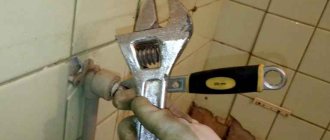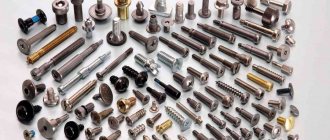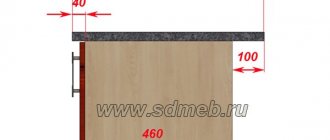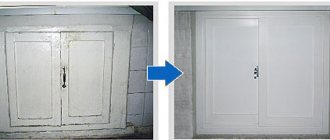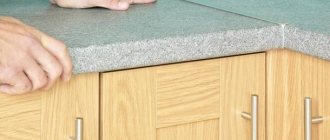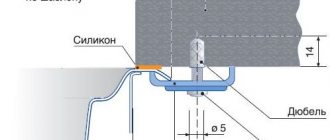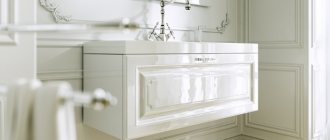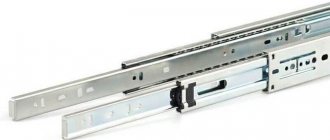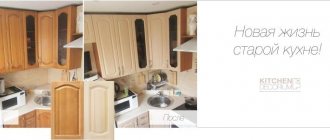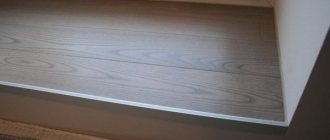Often, when installing a faucet, difficulties arise due to the discrepancy between the distances between the faucet pipes and the water supply pipes. This results in the impossibility of direct connection. In this case, eccentrics for the bathroom faucet turn out to be indispensable, with the help of which the distance between the individual elements is varied by scrolling. Such products are most often included in the mixer kit, so all that remains is to assemble all the parts in accordance with the instructions and install. Some crane models are not equipped with eccentrics or have unsuitable options, for example with insufficient length, which makes it necessary to purchase special adapters.
Hidden and open water supply
Typically, the location for installing the mixer is chosen long before work on laying the tiles begins. This makes it possible to secure the pipes in the grooves, making communications invisible. In this case, the connection pipes must be fixed strictly on a common horizontal axis, plus it is necessary to maintain the exact distance between centers. For this reason, installing a mixer with hidden pipes is much more difficult.
In general, both options have a similar installation procedure. It is optimal if the mixer that will be installed is available at the stage of laying and fastening the pipes. Although the distance between the centers of the pipes for the vast majority of mixers is strictly 150 mm, the fixed pipes can move during the process of finishing the walls, after which it will be very problematic to achieve a neat and aesthetic installation. Therefore, it is best to first assemble the installation “cold”, secure it to the wall, and then dismantle the mixer while laying the tiles.
The simplest installation of the mixer becomes when the water supply network is made using polypropylene pipes. The assortment of fittings for them includes products in which two MR couplings are rigidly fixed to a bar with a stop between the center holes. In this case, all that remains is to drill through the plank and secure it to the wall with quick-installation dowels. When installing metal-plastic or PEX pipes, the fittings will have to be fastened manually, for example, onto clumps of alabaster.
Attaching the shower head holder
How to attach the holder to the wall depends on what material it is made of. If it is concrete, then dowels and screws will be required. Installation steps:
- Mark the location of the fasteners on the wall. A pencil or marker is suitable for this. The holder must be placed at the installation site at the required height and marks must be made through the holes for fasteners. To prevent the drill from sliding on the surface of the tile, you need to slightly damage the smooth coating of the tile using a self-tapping screw or a pobedit drill. It should be placed in the center of the mark and knocked down with a hammer.
- Drill holes and insert dowels into them.
- Secure the watering can holder with self-tapping screws.
Installing a holder in a plasterboard wall lined with tiles is more difficult - you need to know the location of the rack profile or mount it in advance, at the stage of constructing the partition. Only in this case is the secure fixation of the holder guaranteed. The first two stages of installation in drywall are similar to mounting on a concrete wall. You only need to drill the tiles and the adhesive layer. In this case, the holder is attached to metal screws with fine threads.
This completes the self-assembly and installation of the faucet in the bathroom. All that remains is to turn the water supply valve and use the device for its intended purpose. If all the work is done correctly, the tap will not leak for a long time.
Types of eccentrics
The eccentric is actually an adapter that simplifies the installation of the mixer. In some cases, these installation elements are included in the crane kit, in other cases, you have to buy them. The second option is preferable; the delivery package does not always correspond to the ideas of the apartment owners or the features of the pipeline that was inherited.
If there is a shortage, it is often necessary to lengthen the eccentric for the mixer; this can be done using additional adapters, but it is better to use extended models. They look more aesthetically pleasing and do not allow the appearance to be spoiled by not very conscientious plumbers who do not pay any attention to aesthetics. There is a wide variety of models on the market; Grohe offers a very wide range. The proposed options are really enough to solve a number of problems.
Adapters are usually divided (pictured):
- elongated, used when it is necessary to “move” the faucet away from the wall or lower it below the level of the pipes; for this you only need to unscrew and screw additional elements;
- short ones are used for standard installation; differences in length up to 80 mm are compensated.
Also offered are adapters with a socket and in a housing, used for installing expensive plumbing fittings. When selecting, you need to comply with the types of fastening, for example, “father-mother”, “mother-mother”. This refers to the type of internal and external threads, as well as fastening. Of particular interest are the extended adapters. They allow you to install a valve below or above the entry point into the pipeline without carrying out additional major plumbing work.
When might this be needed? For example, if you installed a lower sink, or you don't like water splashing from the faucet into the bathtub. Using long adapters you can make an aesthetic connection. Such eccentrics for the bathroom faucet are made in chrome or gold; they look like part of the structure, which can be unscrewed and replaced at any time with a traditional design.
Why do you need an eccentric for a mixer and is it possible to do without it in old panel houses?
Replacing plumbing fixtures in the bathroom or kitchen is a common task, which, however, requires some skill. Sometimes, without a special device - an eccentric, it is impossible to install a faucet or mixer smoothly.
- Part for easy installation of plumbing fixtures
- What are plumbing eccentrics for faucets?
- Main characteristics
- Kinds
- Short
- Extended
- Long
- Dimensions according to table
- Materials from which eccentrics with nuts are made
- DIY installation and installation in the bathroom
- Tips for choosing
- Manufacturers and prices
- Useful video
Installation on polypropylene pipes in the wall
The mixer is installed on polypropylene pipes using a plastic strip with an internal metal insert. The strip is secured to the pipes so that the outer edge does not protrude above the surface of the tile.
Bar for mounting the mixer on polypropylene pipes
To install the mixer on the wall you must:
- Check the presence of all parts in the kit and clean the bar to which we will screw the mixer;
- Install eccentrics. To do this, you need to check their position inside the fittings along the length and then wrap FUM tape (flax) around the narrower threaded part (which will go into the wall). Winding is carried out along the thread with tension, in several layers (usually about 10 turns) to completely hide the unevenness of the thread. It is carried out from the edge of the product in the shape of a cone. After sealing the threads, screw the eccentrics one by one into the outlets in the wall (along the thread) and using an adjustable wrench, carefully tighten them until they stop;
- Attach decorative covers to make sure that the length of the eccentrics is installed correctly, and the length of the remaining thread is sufficient to screw the faucet. The covers should fit tightly to the wall surface, without gaps. After checking, they should be removed;
- Insert gaskets into the mixer body and screw it to the eccentrics - check the accuracy of the position of the eccentrics along the axes. The gasket is placed with the ribbed side inside the mixer, and the smooth side towards the eccentric terminals. Then open the water and check how tightly the connection was installed;
- If water does not leak out, remove the mixer and install decorative covers. Screw the mixer to the eccentrics manually, then fully compress the nuts using an adjustable wrench. Perform the compression carefully so as not to spoil the shiny coating of the mixer and not to crush the gasket inside. For insurance, place a rag between the key and the nut;
- Turn on the water and check how the finished system works.
Selecting the right model
To purchase a suitable part, you need to know the distance between the pipes and the parameters of the mixer. If the difference in distances is significant, then it is worth buying an extended eccentric with the largest shoulder. Such parts are usually not included in the kit.
The diameter for connecting pipes is 1/2 or 3/4 inches, so the eccentrics fit all standard water pipes. Very rarely there are unusual shapes of products that require an individual approach.
For plastic pipes, the metal of the adapter does not matter, but for metal pipes it is desirable that the materials match. This ensures equal thermal expansion and response to internal water pressure, ultimately eliminating leaks. In any case, with ordinary steel pipes, experts advise choosing brass or bronze products - this will be the best option. Brass adapters must be solid.
Unscrupulous manufacturers spray metal of poor quality, passing off parts as more expensive. With constant contact with water, they quickly break down, fail, and leaks begin. To avoid mistakes, you need to buy eccentrics from suppliers you trust, or contact specialized brand stores.
Installation of a bathroom faucet
Let's start with the fact that installing a faucet on a bathroom sink is no different from installing a kitchen faucet. Therefore, we will immediately move on to the installation of a wall-mounted mixer, as in the first case, leaving out the selection of such a mixer and the dismantling of the old one. A bathroom faucet usually has a shower hose included and, accordingly, a tap-shower water supply switch. Therefore, when assembling the mixer, you need to connect the tap (the mounting principle is the same as for a kitchen tap) and the shower hose. Unlike a kitchen faucet, it is sometimes more convenient to install the faucet and shower hose after installing the faucet body.
Bathroom faucets are attached to the water supply pipes, most often using special fittings called eccentrics. This part has a broken shape with external threads on both ends, one of them being half an inch, which corresponds to the diameter of the pipe for a standard water supply. Eccentrics allow you to adjust the distance between the axes of the supply pipelines and adjust it to what is required for the mixer.
If you do not have a new building, then after dismantling the old mixer, you have water supply pipes walled into the wall, at the end of which “angle” fittings with a 1/2 internal thread are mounted. The eccentrics are installed directly into these fittings, installed on the pipes supplying cold and hot water. The eccentrics are tightened using a gas wrench with thin jaws or an adjustable wrench. It should be understood that in this case it is better to use sanitary flax with a special paste for sealing. In this case, it is necessary that the center-to-center distance between the output eccentrics exactly corresponds to the center-to-center distance of the corresponding mixer outputs, which is 150 mm. In this case, both eccentrics are set strictly horizontally. If you have a new building and the pipes are simply led into the bathroom and end with an external half-inch thread, you will need a coupling with an internal half-inch thread that will connect the eccentric to the supply pipe.
Dismantling
Replacing an eccentric in a bathroom begins with dismantling outdated or unusable equipment. Carrying out the work in this sequence will allow you to correctly select a new device, taking into account all the features of pipe supply and the wishes of the customer.
How to unscrew the eccentric? It is recommended to perform the work in the following sequence:
- shutting off the water supply. If you do not first shut off the flow of water to the mixer, then replacing the eccentrics will lead to flooding of the bathroom and neighbors living on the lower floors;
- disconnecting the shower hose from the mixer;
- dismantling the mixer. To perform this work, it is necessary to loosen the nuts securing the device using an adjustable wrench or wrench of the appropriate size;
Removing the faucet in the bathroom
- removing the reflector - a special decorative device that covers the junction of the pipes and the mixer. The reflector is installed by screwing onto the eccentric. Therefore, to dismantle it, it is enough to unscrew the device;
- dismantling (unscrewing with a wrench) eccentrics.
Unscrewing the device from the pipe
Unscrewing the eccentrics from the pipes must be done extremely carefully so as not to damage the threads on the pipes.
After completing work on removing the eccentrics, it is necessary to clean the walls, pipes and other components from accumulations of dirt, rust and other types of contaminants.
What you need to know about decorative cups
Nickel-plated cups for faucets have the task of hiding the unflattering appearance of fittings, eccentrics, traces of sealant and places where pipes pass through the wall. However, even in such a seemingly trifle there are several tricky nuances.
The first of them: the cup, in which the edge for screwing is made in the form of a straight ring, will become skewed during installation and at the same time an uneven gap will form near the wall. It is best if the inner hole of the cup has the shape of a half-turn or two small protrusions.
The second point: the cups vary in depth, and sometimes their shape does not allow placing a bulky threaded fitting or coupling inside. The length of the cups can be long enough to hide traces of mounting on eccentrics. However, if the cups are too deep, you simply will not be able to screw on the faucet nuts. However, the lack of tightening of 1–1.5 turns can easily be eliminated by lining two o-rings instead of one.
Varieties
There are different types of elements, primarily they differ in the materials used in production. A budget eccentric for faucets, made of metal or brass and chrome-plated, has become quite widespread. Brass products, despite their less attractive appearance, are more preferable, since they do not form rust in threaded connections. Among the disadvantages of inexpensive eccentrics, it is worth noting the high probability of breaking off when unscrewing from water pipes. This leads to additional expenses and complicates the progress of work.
The best option is a solid brass eccentric. Low-cost bathroom faucets are often equipped with yellow-colored products that are made from pressed powder material. They often burst when tightened, are highly fragile and have the only advantage - low cost.
During operation of the faucet, even under slight pressure, it can break off from the wall due to the use of powdered brass products.
What to pay attention to
To properly tighten the eccentric, experts recommend positioning the rod correctly. It should not be twisted too much. Otherwise, the eccentric will not rotate 180 degrees. Then you will not be able to secure the connection. If the rod is not fully tightened, then the parts in the furniture structure will not be connected tightly enough. Which drill bit to choose for an eccentric tie depends on the size of the rod. The hole through which it will be connected to the eccentric is most often made with a diameter of 8 mm.
vote
Article rating
Features of eccentric furniture screeds, installation rules
In the production of furniture, various types of fasteners are used, which ensure the reliability and durability of the structure. The eccentric furniture tie has become the most common in recent years. It is also known as “minifix” or “rastex”. An eccentric tie allows you to fasten elements at different angles, assemble and disassemble products several times. Furniture assembled using such an element is incredibly durable.
- Scope of application
- Materials and equipment
- Installation Rules
Scope of application
Furniture fasteners are used for L-shaped and T-shaped connections. Minifixes are in demand when assembling cabinets, tables, and chests of drawers. They connect the lids and bottoms of cabinets, as well as the tops of computer and dining tables, bedside tables and chests of drawers.
In addition, eccentric furniture ties are used to fasten parts where it is not possible to drill holes. For horizontal elements, such as shelves, it is more convenient to use plastic ties. Bulky structures are assembled using reinforced eccentrics.
Such fasteners are placed in the housing and contain an additional fitting.
The furniture is connected in such a way that the minifixes remain almost invisible. They can only be seen from the inside of the product. This point can be considered an advantage of this type of fasteners, since they do not spoil the appearance of the furniture. The eccentric tie makes assembly of products simple, quick, and also adds additional rigidity to the entire structure.
Materials and equipment
The eccentric coupler consists of 3 elements: a stand, an eccentric and a fitting that acts as a nut. There are several types of fasteners, which can be divided into groups depending on the material of their manufacture, the length of the stand, diameter, size, type of fastening of the self-tapping screw and fitting.
If you often disassemble and reassemble furniture, this type of fastener will be the best option. It is ideal for products made from chipboard and chipboard.
